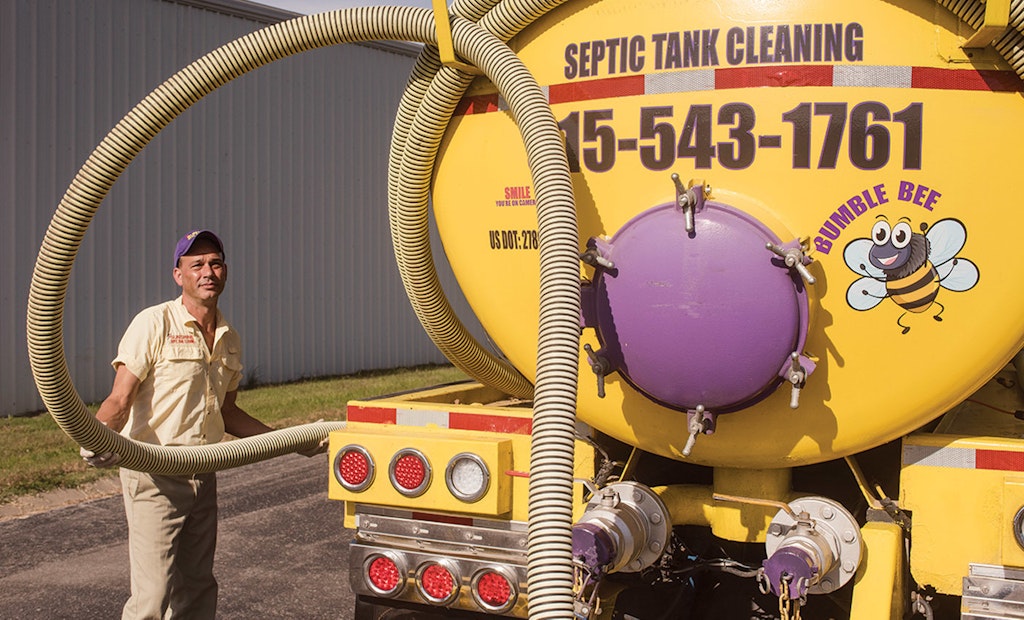
Harris pulls hose at one of the stops on his daily septic service route in the Springfield, Tennessee, area.
Raymond Harris believes he must think outside the box to prosper as a solo septic service operator. Pumping is a difficult business, and Harris makes some — let’s call them unconventional choices — to succeed: Among them, he refuses to excavate septic tank lids, hand-paints his vacuum trucks, directly asks customers to post online reviews of his work, and sometimes makes an unheard of 250-mile round trip to dispose of septage.
All these moves are made to put more money in his wallet at day’s end. And they all bear some explanation from the unorthodox owner of Sunshine Septic in Springfield, Tennessee. Harris, 47, says an intense work ethic learned from his father, Bill Harris, has helped him increase annual revenue by 200 percent since he started pumping three years ago.
“My pumping hours are what I call ‘triple sevens’ — 7 a.m. to 7 p.m., seven days a week. Thanksgiving, Christmas Day — you name it, and I run,” Harris says. “I work too much, but I love it, too. My dad instilled quite a work ethic in us boys. But he also taught us to figure out how to do things ourselves.”
Harris’ policy on excavating for tank lids provides a good example of his thought process. To Harris, the equation is simple: Given the rock-hard soil in his service area (which sometimes requires a pickax to dig), he figures he can go pump two tanks in the time it would take to excavate a lid.
“You can’t really get a shovel in the ground around here in summer,” he says. “I considered buying a mini backhoe, but I didn’t want to incur that kind of expense. So I decided to change the game a bit by asking customers to dig out their own lids.
“People generally are OK with that,” he adds. “And if they don’t want to do it, I refer them to a plumber I know who will run an inspection camera with a sonde out to the tank, figure out where the lid is and dig it out. When it’s ready to rock ’n’ roll, I just back in the truck and I’m gone in 30 minutes.”
RAY OF SUNSHINE
Harris comes from a long line of pumpers, starting with his grandfather, the late Harold Harris, who established Harris Septic in Cohoctah, Michigan, (between Lansing and Detroit) in 1952. Bill Harris bought the company around 1972 and renamed it Harris & Son.
The business was a part-time operation until Raymond Harris’ brother, Charles, took over. Charles still owns the company, which is managed by his son, Austin — the fourth generation of family involvement.
Raymond Harris moved to Tennessee to start a trucking company called Sunshine Truck Line. But he eventually returned to the pumping business by establishing what effectively was a southern arm of the family business, also called Harris & Son. Later he changed the name to Sunshine Septic when he and his brother kept getting calls for each other’s business, illustrating the internet’s extensive marketing reach.
After three years, Raymond Harris remains the company’s sole employee, and he doesn’t expect that to change any time soon. He fears employees wouldn’t share an owner’s commitment and enthusiasm. “All it takes is one bad review on Google and they’ve got you,” he notes. “Plus, employees tend to tear up trucks.”
Harris is proud of Sunshine Septic’s customer reviews. Including more than two dozen five-star reviews online. “Google reviews are the most important thing to customers these days,” he asserts. As an incentive, Harris offers customers a $10 to $20 discount if they write a review while he’s still on the job site.
DISPOSAL ISSUES
There was a time when waste disposal was a vexing issue for Sunshine Septic. The reason: Most of the 11 or so counties the company used to operate in would allow pumpers to dump only waste collected within their boundaries. “It was a paperwork disaster,” Harris says. “Each November, I’d spend about two weeks running from county to county, paying fees and filing paperwork.”
Then Harris heard that the city of Columbia would accept waste from any county. The only problem was Columbia was a two-hour drive away — about a 250-mile round trip. And the city charged $350 a load. But when Harris compared the costs and considered the time-consuming hassle of annual permit renewals, he figured he would actually come out ahead, as counterintuitive as that might seem on the surface.
“It was just a matter of eliminating all that running around,” he says. “It sounded like a lot of money, but when you do the math and look at all the time and fuel you burn …”
Eventually, Harris simplified things even more by shifting his business base primarily to customers living in Robertson County (Springfield is the county seat). The Springfield municipal waste treatment plant accepts waste from customers in Robertson County; Harris takes waste collected from all other customers to Columbia.
“On Sundays, there’s no line at the plant (in Columbia), so I get up, put on my boots, and go for a ride,” he explains. “I actually enjoy it because I know I’m avoiding a lot of headaches and paperwork.”
AN OLDER FLEET
The heart of Sunshine Septic is a distinctive, bright-yellow 1995 Peterbilt 378 truck that Harris had outfitted with a 3,300-gallon steel tank that came off a former Texas oilfield truck and a vacuum pump made by National Vacuum Equipment. He also owns a 1995 Chevrolet Kodiak that carries a 2,000-gallon steel tank and equipped with a Jurop/Chandler pump. Both trucks are bright yellow, hand-painted by Harris.
The pump on the Peterbilt truck is more powerful than a typical vacuum pump, which makes it great for blowing back water from the truck’s tank into a septic tank to agitate thick sludge.
“When you’re a one-man show, you have to think out of the box,” Harris explains. “I was thinking about how to keep labor costs down and save time, so I did some research on powerful oil-rig pumps, which gave me the idea (about using water pressure to agitate sludge). It actually can get pretty exciting. … You’ve got to be ready or you’ll be wearing it (the sludge).”
Harris had to make do without the Peterbilt last early September through mid-December, courtesy of extreme flooding in the aftermath of Hurricane Irma. Sunshine Septic is located in a row of five side-by-side shop buildings along the Sulphur Fork Creek, which overflowed and filled the facilities with 6 feet of water.
The only silver lining for Harris: He had flood-insurance policy, which he took out after he heard the creek had flooded in 2010. The Peterbilt was undrivable, with a waterlogged computer, clutch, pump and transmission. The Kodiak was in a little better shape — drivable, even though the clutch was shot.
“I’m telling you, it got pretty interesting,” Harris says about driving the Kodiak until the clutch could be repaired. “I had to chock the wheels (while pumping) to make sure it wouldn’t roll away. … The emergency brake was shot, too. I paid someone to come on jobs with me.”
KEEP ER’ MOVIN’
Harris says he anticipates Sunshine Septic will continue to grow, noting the advantage of passing the three-year mark. It means customers for whom he cleaned septic tanks during his first year in business will be due for pumping, which should boost revenue going forward.
Moreover, by keeping overhead low — aided by having no employees — and minimizing debt, Harris says he can maximize his profit margins. “I was taught at an early age that it’s not how much money you make, but how much you keep that counts,” he explains.
The main motivation to keep pushing hard? Early retirement. “I don’t want to be still working at 75 and wishing I would’ve thought things out better,” Harris says. “By the time I’m 55 or 57, I’m hoping things will be pretty well set. In the meantime, my plan is to keep growing a very strong, reputable and clean business — keep things simple and efficient.
“And keep thinking outside the box.”
Hand-painting trucks
Raymond Harris may not have a fancy marketing degree, yet he knows full well the value of differentiating his company, Sunshine Septic, from competitors. And he does that in an extremely visible way with his hand-painted, lemon-yellow-with-purple-trim 1995 Peterbilt truck, which he affectionately calls Bumblebee.
“When I was painting it outside, the yellow color attracted bees,” he explains. “So all these bumblebees kept landing on the wet paint.”
Harris is no stranger to painting trucks. When he was a youngster, he used to help his dad, Bill Harris, hand-paint his pumping company’s trucks to save money. “I learned how to make a truck look like it came out of a showroom,” he says.
When Raymond Harris established Sunshine Septic in 2015, he wanted a truck color that would accurately reflect the company’s name. “With a name like Sunshine, it had to be bright,” he says. So he opted for a glossy, safety-yellow oil-based paint made by Rust-Oleum, applied with foam rollers.
Harris estimates it took about 450 hours spread out over six months to prep and paint the truck; he did the work before he started formally serving customers. Overall, he says it took about 20 gallons of safety yellow, about five gallons of purple and roughly six gallons of bright-aluminum paint — all made by Rust-Oleum — to complete the job.
The key to its gleaming finish? An initial coat of white Rust-Oleum paint, followed by a coat of the bright-aluminum paint topped by 12 coats of the safety yellow — 14 coats of paint in all (plus wet-sanding by hand in between each coat with 220-grit sandpaper and scuff pads). “That bright aluminum base makes each subsequent yellow top coat shinier,” he says. “That’s why the yellow is so bright.”
Harris concedes that compared to the expense of the paint and all the hours he put into the job, he probably could’ve had the truck painted professionally much faster and at less cost. But he says he never considered even getting an estimate. “It’s not about the money — it’s about memories,” he explains. “Doing it by hand takes me back to being a kid. I’ve got to do it the old-school way, family-style. Plus, it won’t look as bright if I have someone else paint it.”
Customers’ reactions to the truck makes all the long hours of painting and sanding worthwhile; they typically are impressed when Harris pulls up on a job. “They say, ‘My God, that’s a beautiful truck — I can’t believe how bright it is,’” he says. “I do a professional job, so I want a professional-looking truck. It tells my customers a lot about me and my business.”
The truck likely will need to be repainted every three years or so, which will require Harris to mask off all the vinyl lettering before he repaints. “It’s a lot of work,” he notes. “But the results are well worth it.”









